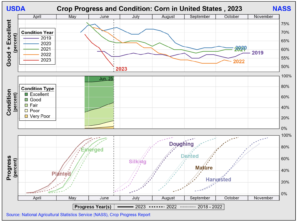The Agriculture Department has finalized some revisions to two major farm commodity programs, including rules for adding new base acres, but signup for the programs won’t be scheduled until after…
For Third Week in a Row, Corn and Soybean Conditions Fall
DTN Managing Editor Anthony Greder reported yesterday that, “U.S. corn and soybean conditions declined for the third week in a row during the week ended Sunday, June 25, according to USDA NASS’ weekly Crop Progress report released Monday.

“A system that moved across the country over the weekend brought some good rainfall coverage, but most areas saw near- or below-normal amounts for the week. And some key dry areas were missed in Kansas, Missouri and much of Illinois.
#Illinois Topsoil Moisture pic.twitter.com/X5m863fuWy
— FarmPolicy (@FarmPolicy) June 26, 2023
“Despite the good rain coverage, it appears to have come too late to have an impact on crop conditions for last week, said DTN Ag Meteorologist John Baranick.”
30- Day Percent of Normal Precipitation pic.twitter.com/4nzAbpyYot
— FarmPolicy (@FarmPolicy) June 26, 2023
Greder indicated that, “Nationally, corn was rated 50% good to excellent, down another 5 percentage points from 55% the previous week and below last year’s rating at this time of 67%.

“The current rating is the lowest for the crop at this time of year since 1988, said DTN Lead Analyst Todd Hultman. Double-digit declines were seen in corn ratings in Missouri, Illinois and Minnesota last week, he noted.”
#Illinois #Corn Condition pic.twitter.com/lipDKXpSeM
— FarmPolicy (@FarmPolicy) June 26, 2023
The DTN article added that, “Soybeans were rated 51% good to excellent as of Sunday, down 3 percentage points from 54% last week and below last year’s rating at this time of 65%. As with corn, the current rating is the lowest for the crop since 1988, Hultman said. ‘Missouri’s soybean rating lost 12 percentage points, and the three I states lost 8 to 10 points each,’ he said.”

Reuters writer Naveen Thukral reported today that, “Chicago soybean futures slid nearly 1% on Tuesday, while corn lost ground as expectations of much-needed rains in parts of the U.S. Midwest eased concerns over dry weather which has threatened yields.”
July 2nd to July 6th Outlook pic.twitter.com/YYFZRw0AV6
— FarmPolicy (@FarmPolicy) June 26, 2023
“The condition of U.S. corn and soybean crops deteriorated to the worst in decades, U.S. government data showed on Monday, as major producing areas missed out on much-needed rains,” the Reuters article said.
Elsewhere, Dow Jones writer Kirk Maltais reported yesterday that, “Analysts are forecasting this week’s planted acreage report from the USDA will show only minor differences between the amount of crop acres planted by farmers versus the projections from the USDA released in March.”
The Dow Jones article also noted that, “Inspections of U.S. grain exports slid for the week ended June 22. In its latest grain export inspections report, the government said corn export inspections totaled 542,727 metric tons, soybean inspections added up to 141,158 tons and wheat inspections totaled 203,724 tons.”
More broadly, Reuters writer Emma Farge reported yesterday that, “An end to the Black Sea grains deal would hit the Horn of Africa hard, aid officials said on Monday, warning that another hike in food prices would add to the tens of millions of people facing hunger.
“Moscow has been threatening to walk away from the deal known as the Black Sea grain initiative – brokered by the United Nations and Turkey in July last year – if obstacles to its own grain and fertilizer shipments are not removed. A Ukrainian envoy has said he was 99.9% certain Russia would quit when it comes up for renewal on July 18.”
Also yesterday, Reuters writer Gabriel Araujo reported that, “Brazilian farmers have harvested through last Thursday 9.3% of the area planted for their second corn crop in the center-south region, agribusiness consultancy AgRural said on Monday, up 4.6 percentage points from the previous week.”





